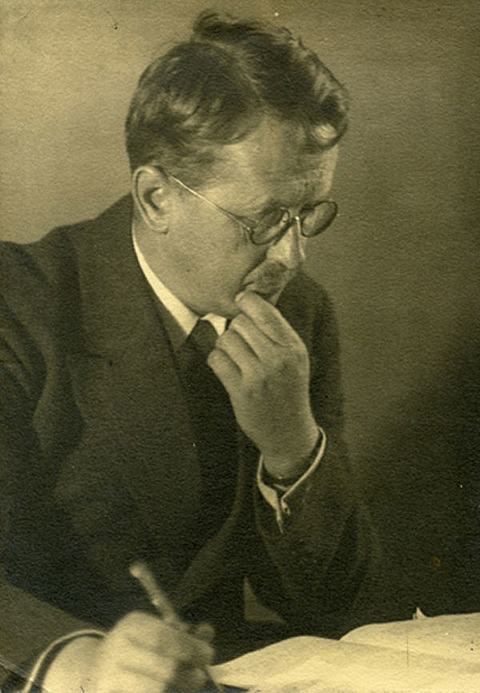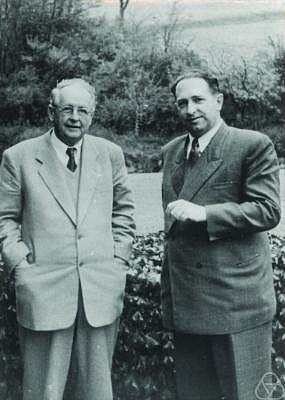Hermann Weyl: Legacy
“My work always tried to unite the truth with the beautiful, but when I had to choose one or the other, I usually chose the beautiful,” said Hermann Weyl, who served on the Institute Faculty from 1933 until his death in 1955. Among all the mathematicians who began their working lives in the twentieth century, Weyl stands out as the one who made major contributions in the greatest number of different areas.

He viewed the field of mathematics as an organic whole rather than a series of individual subjects. His work spanned many areas, including topology, differential geometry, Lie groups, representation theory, quantum mechanics, harmonic analysis, and analytic number theory, and had a major impact on the progress of the entire field of mathematics.
In the Mathematical Intelligencer (1984, vol. 6 no.1), Michael Atiyah (Professor, School of Mathematics, 1969–72) noted that whenever he examined a mathematical topic, he found that Weyl had preceded him. “Weyl was probably the most influential mathematician of the twentieth century,” Atiyah wrote in the Proceedings of Symposia in Pure Mathematics (Vol. 48, 1988). “The topics he chose to study, the lines he initiated and his general outlook have proved remarkably fruitful and have underpinned much of the development of the past fifty years.”
On the occasion of his 70th birthday on November 9, 1955, Weyl was in Zurich being feted by the ETH. During the celebration, he received congratulations from the Faculty of the Institute, sent by the Director J. Robert Oppenheimer. The message read, in part, “Like all the world of science and scholarship, we honor you for your great and long-continued contributions to creative mathematics and for your wide-ranging and profound illumination of philosophical thought, but we also wish to assure you of our sincere and abiding gratitude for the universal interest and untiring devotion that you have lavished upon our Institute in all its aspects from its earliest years, for your wise counsel and energetic service, to which we owe such a large measure of its successful development, and for the genial humanity with which you have endeared yourself to all of us. We are proud and happy that even after your formal retirement, you continue to give us a portion of your time each year and renew by your presence the spirit that you implanted here. May you long continue in health and happiness to give the world the benefit of your creative thought and teaching and to give us the pleasure of your company.”

Weyl responded with thanks to the Faculty for remembering his birthday and said, “To the last breath of my life I shall be grateful for what the Institute has given me: a free and untrammeled opportunity for working in solitude and for communicating under ideal conditions with the many scientists who passed through our gates as temporary members; above this: the enjoyment of the friendship of my colleagues and of our always perfectly harmonious collaboration.
“I hope these ties will never break!”
A month later, completely unexpectedly, Weyl died.
An obituary appeared in Nature in early 1956, written by Freeman Dyson, then a recent addition to the Faculty at the Institute and today Professor Emeritus in the School of Natural Sciences. It sums up Weyl’s impact on the field of mathematics. “Among all the mathematicians who began their working lives in the twentieth century, Hermann Weyl was the one who made major contributions in the greatest number of different fields. He alone could stand comparison with the last great universal mathematician of the nineteenth century, Hilbert and Poincaré. So long as he was alive, he embodied a living contact between the main lines of advance in pure mathematics and in theoretical physics. Now he is dead, the contact is broken, and our hopes of comprehending the physical universe by a direct use of creative mathematical imagination are being ended.”
In the National Academies Press Biographical Memoirs (Vol. 82, 2003), Atiyah wrote, “It is somewhat unusual to write a biographical memoir nearly fifty years after the death of the subject . . . [Weyl’s] contemporaries are long since gone and only a few personal reminiscences survive. On the other hand the passage of time makes it easier to assess the long-term significance of Weyl's work, to see how his ideas have influenced his successors and helped to shape mathematics and physics in the second half of the twentieth century. In fact, the last fifty years have seen a remarkable blossoming of just those areas that Weyl initiated. In retrospect one might almost say that he defined the agenda and provided the proper framework for what followed. He made fundamental contributions to most branches of mathematics, and he also took a serious interest in theoretical physics.”
In a memorial to Weyl in American Scientist (Vol. 74, July–August 1986, pp. 366–375), John Archibald Wheeler (Member in the School of Mathematics [Natural Sciences], 1937) wrote: “As we face these stirring challenges, a warm memory gives us courage. Hermann Weyl has not died. His great works speak prophesy to us in this century and will continue to speak wisdom in the coming century. If we seek a single word to stand for the life and work of Hermann Weyl, what better word can we find than passion? Passion to understand the secret of existence was his, passion for that dear, luminous beauty of conception which we associate with the Greeks, passionate attachment to the community of learning, and passionate belief in the unity of knowledge.”